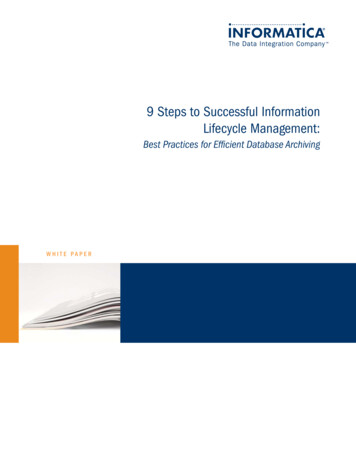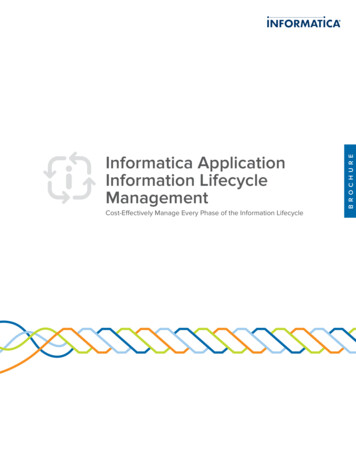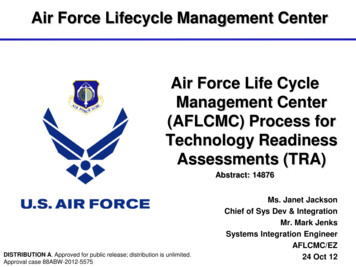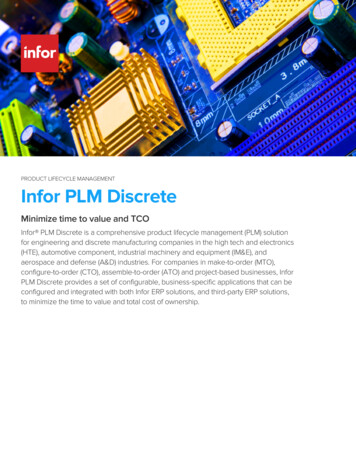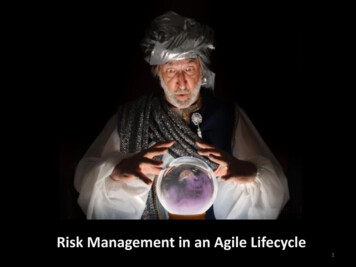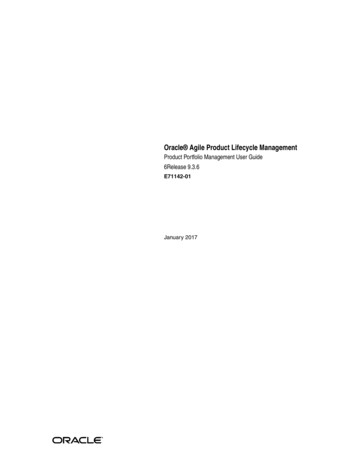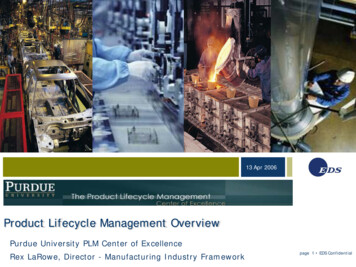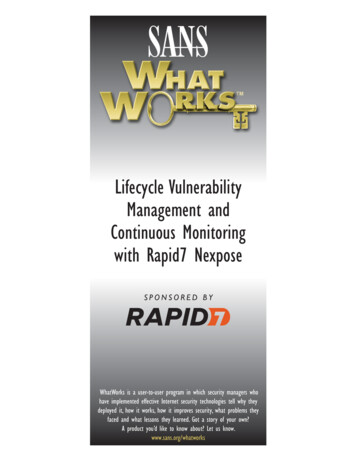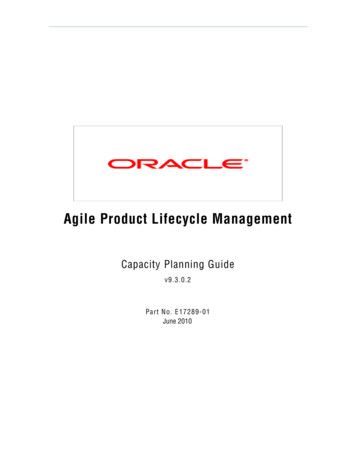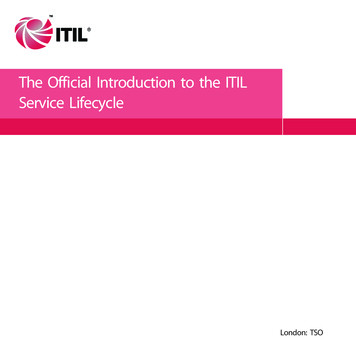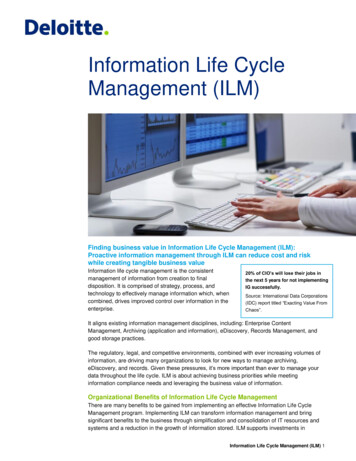
Transcription
Information Life CycleManagement (ILM)Finding business value in Information Life Cycle Management (ILM):Proactive information management through ILM can reduce cost and riskwhile creating tangible business valueInformation life cycle management is the consistentmanagement of information from creation to finaldisposition. It is comprised of strategy, process, andtechnology to effectively manage information which, whencombined, drives improved control over information in theenterprise.20% of CIO’s will lose their jobs inthe next 5 years for not implementingIG successfully.Source: International Data Corporations(IDC) report titled “Exacting Value FromChaos”.It aligns existing information management disciplines, including: Enterprise ContentManagement, Archiving (application and information), eDiscovery, Records Management, andgood storage practices.The regulatory, legal, and competitive environments, combined with ever increasing volumes ofinformation, are driving many organizations to look for new ways to manage archiving,eDiscovery, and records. Given these pressures, it’s more important than ever to manage yourdata throughout the life cycle. ILM is about achieving business priorities while meetinginformation compliance needs and leveraging the business value of information.Organizational Benefits of Information Life Cycle ManagementThere are many benefits to be gained from implementing an effective Information Life CycleManagement program. Implementing ILM can transform information management and bringsignificant benefits to the business through simplification and consolidation of IT resources andsystems and a reduction in the growth of information stored. ILM supports investments inInformation Life Cycle Management (ILM) 1
enterprise information management to produce defined increases in specific businesscapabilities.Corporations can realize several benefits including: Reduced risk: Reduce unneeded and expired information, and make your informationeasier to manage and discover. Reducing the volume of unneeded information lessens therisk of unfavorable content being discovered (or leaking). Additionally, knowing where tolook for electronically stored information (ESI) reduces the chance of missing criticalinformation when searching. Cost savings: eDiscovery, storage, and legal hold costs can be reduced with bettermanagement of information. Reducing “digital debris” decreases the overall scope ofsearch and improves the chances of finding critical information in a timely manner. Further,reducing the volume of duplicates and non-value-added information directly impacts costof discovery. Improved service: Archiving, eDiscovery, and Records Management may become lessof a distraction and drain on IT and Legal. IT, Legal, and Business can focus more oncustomers and executing business strategy and less time on managing information andeDiscovery requests. More effective governance: ILM can introduce management rigor and controls that benefitthe enterprise. ILM can bring the added bonus of improved management of information forthe entire business.The cost savings of implementing an Information Life Cycle ManagementProgram are tangibleThe foundational financial impact of an ILM program is based on both hard and soft dollarbenefits to your organization.Information Life Cycle Management (ILM) 2
There are significant monetary savings that can be gained from the implementation of anInformation Life Cycle program. You can reduce costs by: Data storage: Eliminating the cost of storing and maintaining information that has reachedthe end of its useful life or that exists as redundant and intermediate versions. eDiscovery: Reduce the aggregate cost associated with eDiscovery data collection,processing, hosting and review. Application decommissioning: Eliminating the costs associated with maintainingapplications that have been designated as read-only and have reached the end of theiruseful life.There are also soft dollar savings from the implementation of an Information Life Cycle program.Your organization can enhance productivity through: Findability: Decrease knowledge worker time required tolocate needed information. Reduce search time due tomultiple file copies or inadequate metadata.eDiscovery: Improve productivity of individual custodiansadhering to a legal hold order.Studies have found that aknowledge worker on averagespends 30% of their time lookingfor information!Source: Delphi Group Reuse/Repurposing: Reduce unnecessary documentrecreation and ‘reinventing the wheel’. Personal Records Administration: Reduce the amount of manual administration requiredfor knowledge workers to manage discretionary data.Information Life Cycle Management (ILM) 3
Further, your organization should be able to mitigate risk through: Control: Improve the precision of applying legal holds. Provide mechanisms that increasethe security of information assets. Quality: Improve information timeliness, relevance, trustworthiness, and transparency.Facilitate automated information monitoring.Productivity can be enhanced through: Collaboration: Facilitating information sharing, personalization, and skill-basedinformation mapping. Process Efficiency: Decreasing time required to complete information-intensive processes.Improving the agility of information delivery.Opportunity can be driven by: Decision-making: Enabling intuitive business analytics that provide solutions torecurring issues. Information Delivery: Facilitating automated information delivery tailored to individualknowledge worker needs.Information Life Cycle Management is adding business value to both the enterprise andindividual knowledge worker. How much longer will you wait to implement this costsaving program?Information Life Cycle Management (ILM) 4
To learn how you can put information to work for you to reduce costs and generate newrevenue streams by implementing an Information Life Cycle Management plan at yourorganization, contact:Matthew LarsonPrincipal, Deloitte AdvisoryDeloitte DiscoveryDeloitte Transactions and Business Analytics LLPmalarson@deloitte.com 1 404 220 1637Scott ReadPrincipal, Deloitte AdvisoryDeloitte DiscoveryDeloitte Transactions and Business Analytics LLPsread@deloitte.com 1 612 397 4702Bryan FosterDirector, Deloitte AdvisoryDeloitte DiscoveryDeloitte Transactions and Business Analytics LLPbfoster@deloitte.com 1 713 982 2747This publication contains general information only and Deloitte is not, by means of this publication, rendering accounting, business, financial, investment, legal, tax, orother professional advice or services. This publication is not a substitute for such professional advice or services, nor should it be used as a basis for any decision oraction that may affect your business. Before making any decision or taking any action that may affect your business, you should consult a qualified professional advisor.Deloitte shall not be responsible for any loss sustained by any person who relies on this publication.About DeloitteAs used in this document, “Deloitte" means Deloitte & Touche LLP, which provides audit and enterprise risk services; Deloitte Financial Advisory Services LLP, whichprovides forensic, dispute, and other consulting services; and its affiliate, Deloitte Transactions and Business Analytics LLP, which provides a wide range of advisory andanalytics services. Deloitte Transactions and Business Analytics LLP is not a certified public accounting firm. These entities are separate subsidiaries of Deloitte LLP.Please see www.deloitte.com/us/about for a detailed description of the legal structure of Deloitte LLP and its subsidiaries. Certain services may not be available to attestclients under the rules and regulations of public accounting.Copyright 2015 Deloitte Development LLC. All rights reserved.Member of Deloitte Touche Tohmatsu LimitedInformation Life Cycle Management (ILM) 5
Information life cycle management is the consistent management of information from creation to final disposition. It is comprised of strategy, process, and technology to effectively manage information which, when
